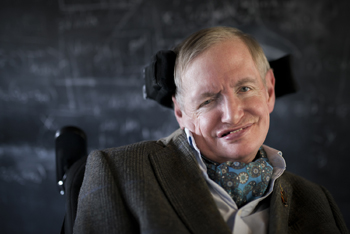
Plus Advent Calendar Door #11: The information paradox
On this, the eleventh day of advent, we explore an unresolved puzzle in theoretical physics which greatly intrigued the famous physicist Stephen Hawking. It's about black holes and what happens to information that falls into them.

Stephen Hawking. Photo courtesy Andre Pattenden.
To understand the paradox imagine a library containing reams and reams of information. Ultimately this information is inherent in the molecular make-up of the pages and the ink upon them: there is no information without physical manifestation. If the library burns down, then for ordinary humans that's a tragedy: all the information is lost.
From the point of view of physics, in particular quantum physics, things are not that bad. As a physical system the library is described by a mathematical object called a wave function (find out more here). As it burns, changing shape and consistency, the wave function changes accordingly. At the end the wave function describes the ashes that remain. No information is lost in the process, it is simply transformed. In theory, you can run the evolution of the wave function backwards and recover all the original information from the wave function about the ashes.
This is pure theory, of course, we can't do it in practice, not least because don't yet understand the quantum mechanics of large things like libraries. But within its limits the theory is sound.
Now imagine the library doesn't catch fire, but instead becomes smaller and smaller while retaining its mass. Its gravitational pull would become stronger and stronger (a small object has a stronger pull than a larger one of the same mass) until a black hole is formed. According to the no hair theorem, a famous result proved by Hawking in 1970, the black hole is simple: we only need its mass, spin, and electric charge to describe it. We can't tell any longer whether it formed from a library or a featureless rock. According to another famous result by Hawking the black hole emits a form of radiation, evaporating as it does so. But the radiation that remains after the black hole has evaporated is also independent of what has gone into the black hole when it was formed. In other words, all the information that was inherent in the library has been wiped out.
And that's the paradox: according to Hawking's results black holes are able to devour information, but according to quantum mechanics information loss is not allowed. So who is right?
Many physicists decided to come down on the side of quantum mechanics, insisting that there must be some way of explaining the paradox that does not lead to information loss. Hawking himself for a very long time insisted that quantum mechanics was wrong instead, and needed to be modified to allow information loss.
In 1997 Hawking, together with Kip Thorne, entered a bet with John Preskill about who was right, in which
"the loser(s) will reward the winner(s) with an encyclopedia of the winner's choice, from which information can be recovered at will.
In 2004, Hawking changed his mind after reading the work of his fellow physicist Juan Maldacena. Hawking conceded the bet, saying he now believed that black holes eventually transmitted all the information that went into them, if in garbled form. Honouring his promise he presented Preskill with a copy of Total Baseball, The Ultimate Baseball Encyclopedia, and later joked, "I gave John an encyclopedia of baseball, but maybe I should just have given him the ashes."
Kip Thorne has to date refused to concede the bet, and in general the jury on how one might resolve the paradox is still out.
This year's advent calendar was inspired by our work on the documentary series, Universe Unravelled, which explores the work done by researchers at the Stephen Hawking Centre for Theoretical Cosmology and is available on discovery+. Return to the 2020 Plus Advent Calendar.